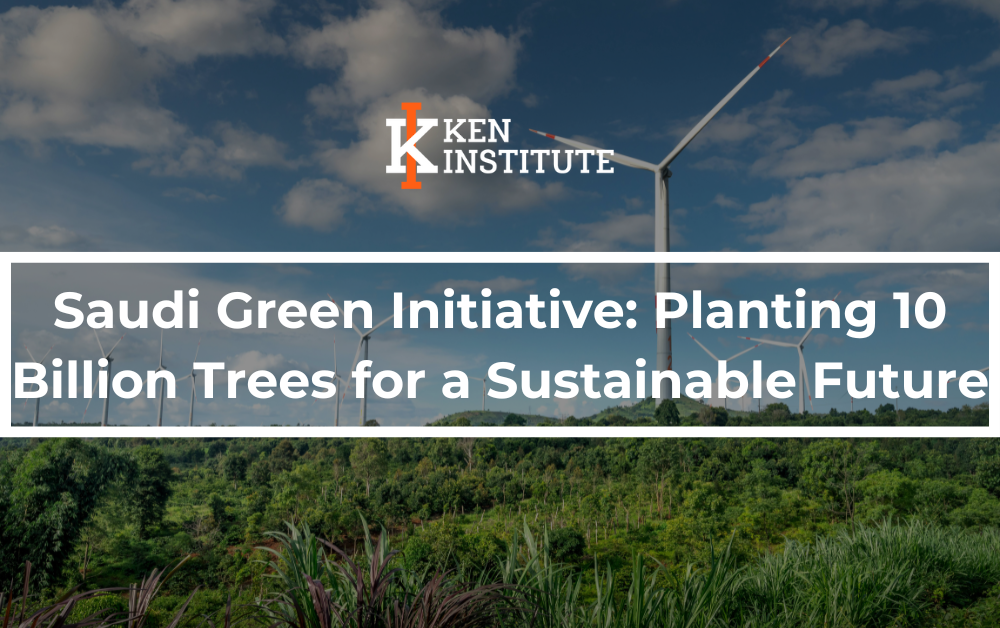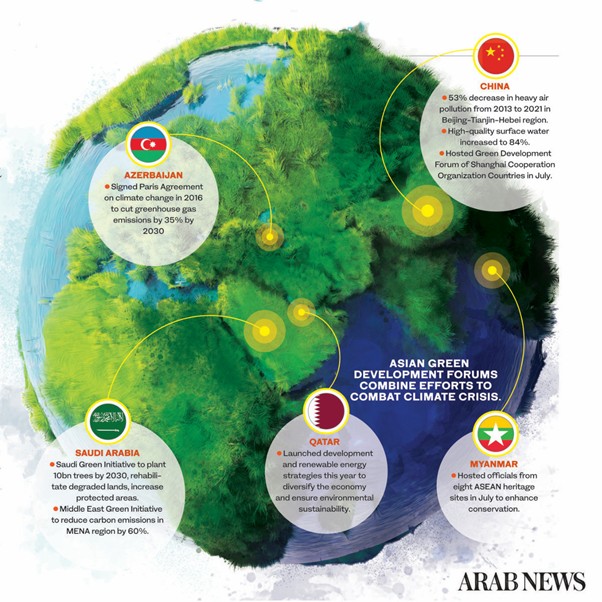
The Saudi Green Initiative (SGI) is a major sustainability project launched in March 2021 by Saudi Arabia, under the leadership of Crown Prince Mohammed Bin Salman. Its core mission is to combat climate change, enhance the quality of life, and protect the environment for future generations. SGI is a cornerstone of Saudi Vision 2030, the country’s strategic framework for economic and societal transformation.
Preferences
The Saudi Green Initiative stands as one of the world’s largest reforestation policies, addressing desertification, biodiversity loss, and climate resilience, with a clear roadmap toward a sustainable future.
SGI’s primary focus is on three aspects:
Afforestation: Planting 10 billion trees across Saudi Arabia over the coming decades, targeting rehabilitation of more than 74 million hectares of degraded land
Emissions Reductions: Cutting carbon emissions by more than 278 million tons annually by 2030. The initiative seeks integration of renewable energy, aiming for 50% of the country’s power from clean sources by 2030.
Land and Sea Protection: Safeguarding 30% of the nation’s terrestrial and marine environments, along with biodiversity conservation and sustainable fishing.
Current Progress
As of March 2025, more than 137 million trees have been planted and over 310,000 hectares of degraded land have been rehabilitated. Between 2017 and 2023, 41 million trees were planted; large-scale progress has been achieved recently through intensified efforts.
Sustainable Impact of The Saudi Green Initiative
Urban Benefits: Planting trees in city centers is expected to lower local temperatures by up to 2.2°C and improve air quality.
Job Creation: SGI creates diverse job opportunities including tree planting, seed collection, park and reserve creation, sustainable urban irrigation, and ecological monitoring.
Biodiversity Restoration: Efforts include planting native species suitable for Saudi Arabia’s varied habitats such as mangrove forests, mountain forests, wetlands, and valleys, boosting ecological resilience.
Global Contribution: Saudi’s target represents 1% of the global goal to plant one trillion trees and 20% of the 50 billion trees aimed for by the Middle East Green Initiative.

Image Source: neais.net
Key Strategies for Planting 10 Billion Trees in Saudi Arabia
Comprehensive Scientific Planning
Feasibility Studies: A two-year, science-driven feasibility study identified optimal planting areas through over 1,150 field surveys, analyzing soil, water, climate, elevation, and wind patterns to determine ecological suitability for different tree species.
Geospatial Analysis: Advanced mapping technologies help pinpoint the most effective sites for planting across the Kingdom.
Phased Implementation
Phase 1 (2024–2030): Focuses on nature-based rehabilitation, aiming to plant more than 600 million trees and restore 3.8 million hectares by 2030.
Phase 2 (2030 onward): Accelerates the target with human-driven, large-scale afforestation efforts to reach the 10 billion mark.
Sustainable Species Selection and Irrigation
Native Species: Only native and climate-resilient trees and shrubs are selected, ensuring high survival rates and ecological compatibility.
Water Management: Innovative and sustainable irrigation methods are deployed, such as reuse of treated wastewater, use of drought-tolerant species, and rainwater harvesting to counter arid climate and limited rainfall.
Urban and Rural Focus
Cities & Highways: Tree planting stretches beyond wilderness, targeting urban centers, roadsides, greenbelts, parks, and residential areas, aiming to reduce city temperatures and improve air quality.
Ecosystem Restoration: Special focus on reforestation of mangroves, wetlands, valleys, and mountains enhancing the richness of Saudi habitats.

Image Source: arabnews.com
Job Creation and Community Engagement
Employment Opportunities: The initiative creates jobs in tree planting, seed collection, land preparation, development and maintenance of irrigation systems, and environmental monitoring.
Public Involvement: Citizens and local communities are engaged through education, volunteer programs, and entrepreneurship in green projects.
Monitoring, Research, and Collaboration
Continuous Assessment: Ongoing monitoring and evaluation, supported by government agencies and scientific experts, ensures adaptive management and optimization of the project’s progress.
International Partnerships: Engage with global organizations and experts to share best practices, innovations, and technologies for large-scale greening.
Economic and Social Co-Benefits
Green Economy: The initiative stimulates green jobs, entrepreneurship, and sustainable development, aligning with Saudi Vision 2030.
Climate & Health Impact: Expected reduction in sandstorms and air pollution, and improvement in public health and ecological resilience.
“These strategies collectively enable Saudi Arabia to overcome environmental constraints and move toward achieving one of the world’s largest afforestation targets.”
Scientific Methods Underpinning Saudi’s Green Initiative Strategies
The main approaches include:
Detailed Feasibility Studies and Field Surveys
Comprehensive field surveys: More than 1,150 field surveys were conducted to map soil types, water availability, climate zones, elevation, and wind patterns across the nation, helping identify optimal locations and suitable species for afforestation.
Geospatial analysis and mapping: Advanced GIS and remote sensing technologies are used to assess vegetation cover, land degradation, and land suitability for planting.
Climate and Soil Adaptation
Selection of resilient native species: The choice of trees and shrubs favors native, drought-tolerant varieties to maximize survival rates and ecological compatibility.
Soil improvement: Scientific soil assessment guides the use of amendments, mulching, and organic material to boost fertility and water retention in sandy, nutrient-poor soils.
Water Management Innovations
Drip Irrigation and treated wastewater: Deployment of advanced irrigation techniques and the use of recycled treated wastewater enable efficient water use, which is critical in desert ecosystems.
Rainwater harvesting: Systems are put in place to capture and utilize rare rainfall events for tree irrigation and land rehabilitation.
Monitoring and Artificial Intelligence
AI-based drought and desertification models: Artificial intelligence is increasingly used for forecasting drought, monitoring desertification, and creating effective mitigation strategies.
Continuous vegetation and land quality monitoring: Satellite imagery and on-ground data collection support regular assessment and adaptive management of planted areas.
Biodiversity and Ecosystem Restoration
Ecological restoration approaches: Afforestation includes habitat restoration for mangroves, wetlands, mountains, and valleys to reconstruct natural ecosystems and boost biodiversity.
Green belts and buffer zones: Creation of strategic green belts around cities and roads helps stabilize sand movement and reduce desertification.
Sustainable Agroforestry and Socio-Economic Research
Promotion of fruit trees: Research focuses on cultivating fruit trees that provide additional food security and economic opportunities.
Socio-economic impact evaluation: Long-term studies evaluate the environmental, economic, and social impacts of afforestation.
International Knowledge Transfer and Best Practices
Global collaborations: Saudi Arabia partners with international organizations and experts to adopt best practices in large-scale reforestation, water efficiency, and sustainable land management.
“These scientific strategies ensure that tree planting is both ecologically sustainable and resilient, tailored to the challenges of desert regions, and aligned with global standards for biodiversity and climate resilience.”
Unified Scientific Framework
Saudi Arabia’s afforestation efforts are closely guided by scientific research.
The main ways scientific research that shapes these initiatives:
Strategic Frameworks: Authorities develop clear guidelines based on comprehensive scientific studies and strategic planning to dictate where, how, and which species to plant, maximizing success rates and environmental impact.
Land Restoration Guide: Saudi Arabia has published an official Land Restoration Guide for Non-Agricultural Areas, which acts as the unified reference point for all restoration projects, ensuring scientifically sound techniques are used in every region.

Image Source: mdpi.com
Data-Driven Site Selection and Species Choice
Field Surveys: Extensive field surveys are conducted to assess soil, water, climate, and terrain conditions, thus guiding site selection and species choice.
Native and Resilient Species: Scientific research assesses which native species are most suited to local conditions, improving survival and ecological compatibility.
Monitoring, Restoration, and Adaptive Management
Continuous Monitoring: Planted areas are monitored for health, survival rates, and biodiversity impacts using ongoing scientific data collection.
Restoration Before Planting: Research shows that protecting degraded areas, caused by desertification, overgrazing, or human activity, precedes planting to help ecosystems recover naturally.
Innovation and Technology
Rainfall and Treated Water: Scientific research underpins use of rainfall capture and treated water for irrigation, reducing pressure on natural water resources.
Cloud-Seeding and Modern Tech: The integration of modern technologies including cloud-seeding to increase rainfall and advanced water management systems reflects ongoing innovation.
Collaborative and Inclusive Approach
Expert Panels and Events: Saudi Arabia convenes expert events to align on best practices and share scientific knowledge, bringing together professionals, civil society, and international partners.
Local and Regional Collaboration: Research institutions, government agencies, and community organizations contribute context-specific data and recommendations, ensuring strategies are regionally relevant.
“Scientific research is the foundation of Saudi Arabia’s afforestation strategies, informing every step from site selection and species choice to ongoing monitoring and advanced irrigation techniques.”
Specific Scientific Techniques Used To Combat Desertification
Seed Biopriming and Seed Encapsulation: Treating seeds with beneficial microorganisms to improve seed viability, germination, and water-use efficiency in arid and degraded soils.
Fog Harvesting Nets: Installing mesh nets to capture moisture from fog in arid regions, using the collected water for irrigation and supporting vegetation growth.
Biosaline Agriculture and Halophyte Cultivation: Growing salt-tolerant plants (halophytes) like Salicornia and Atriplex on saline or degraded soils to improve land fertility.
Desertification Adaptation Zones: Designating specific areas for targeted interventions such as sustainable agriculture, soil conservation, and ecosystem restoration supported by community incentives.
Early Warning Systems: Utilizing remote sensing, ground sensors, and environmental data to monitor and predict desertification trends, enabling timely and informed interventions.
Soil Quality Improvement: Techniques like contour trenching, windbreaks, and the use of leguminous plants or mycorrhiza fungi to improve soil fertility, reduce erosion, and enhance water retention.
Farmer-Managed Natural Regeneration (FMNR): Promoting natural sprouting of native trees through selective pruning, increasing soil moisture retention and reducing desert spread.
Nuclear Technology Applications: Using isotopic and radionuclide techniques for assessing soil erosion and optimizing soil and water conservation measures.
Sand Fences and Checkerboard Barriers: Engineering controls to stabilize soil, reduce wind erosion and protect young vegetation.
Managed Grazing Practices: Controlled movement of livestock to prevent overgrazing and promote grassland regeneration.
“These techniques combine biological, engineering, and technological approaches and are supported by continuous monitoring and adaptive management to effectively fight desertification.”
Early Warning Systems
Early warning systems are critically important for managing desertification risks because they enable proactive, informed responses. The key reasons why early warning systems matter include:
Risk Awareness and Knowledge: They provide timely information about land degradation and desertification hazards, helping to understand the risks and vulnerabilities in vulnerable areas.
Monitoring and Forecasting: Early warning systems integrate real-time data from remote sensing, weather forecasts, and ground observations to continuously track environmental changes and anticipate desertification progression.
Informed Decision-Making: They equip governments, communities, and land managers with actionable data for planning mitigation measures.
Stakeholder Communication and Preparedness: These systems facilitate effective communication of risks to at-risk populations and decision-makers, enabling timely preparation and response, reducing losses and hardship.
Support for Sustainable Development Goals: Early warning contributes to food security, ecosystem resilience, climate adaptation, and poverty reduction objectives aligned with global agendas.
Cost-Effectiveness: Advance warnings can significantly reduce economic losses and human suffering by allowing preventive and adaptive actions rather than costly remediation after degradation has worsened.
Adaptive Management: These systems enable continuous monitoring and evaluation, supporting adaptive strategies that evolve with changing environmental conditions and emerging risks.
“Early warning systems act as vital tools for disaster risk reduction and sustainable land management in desertification-prone regions, enhancing resilience and safeguarding livelihoods through anticipation rather than reaction. They represent an integral part of holistic environmental governance frameworks globally”
Achievements from SGI to Date (2025)
Trees Planted: Over 137 million.
Land Rehabilitated: More than 310,000 ha.
Protected Areas: 4.4 million ha designated to ensure vegetation sustainability.
Investments: More than SAR705 billion invested in green economy projects and sustainability programs.
Partnerships: Over 205 entities involved, including government agencies, private sector partners, and non-profits.
In Essence
All these endeavours ensures the country’s ambitious goal of Green Initiative of planting 10 billion trees across Saudi Arabia over the coming decades!
Join Us,
Join us and unlock a world of online courses in Mechanical Engineering, Occupational Health and Safety, Fire Safety, and Environment and Sustainability. Propel your career to new heights.
Propel your career to new heights.
Connect now and take the next step toward professional excellence!
+91 7569034271
Let’s connect together on: Facebook, YouTube, LinkedIn, and Instagram.

